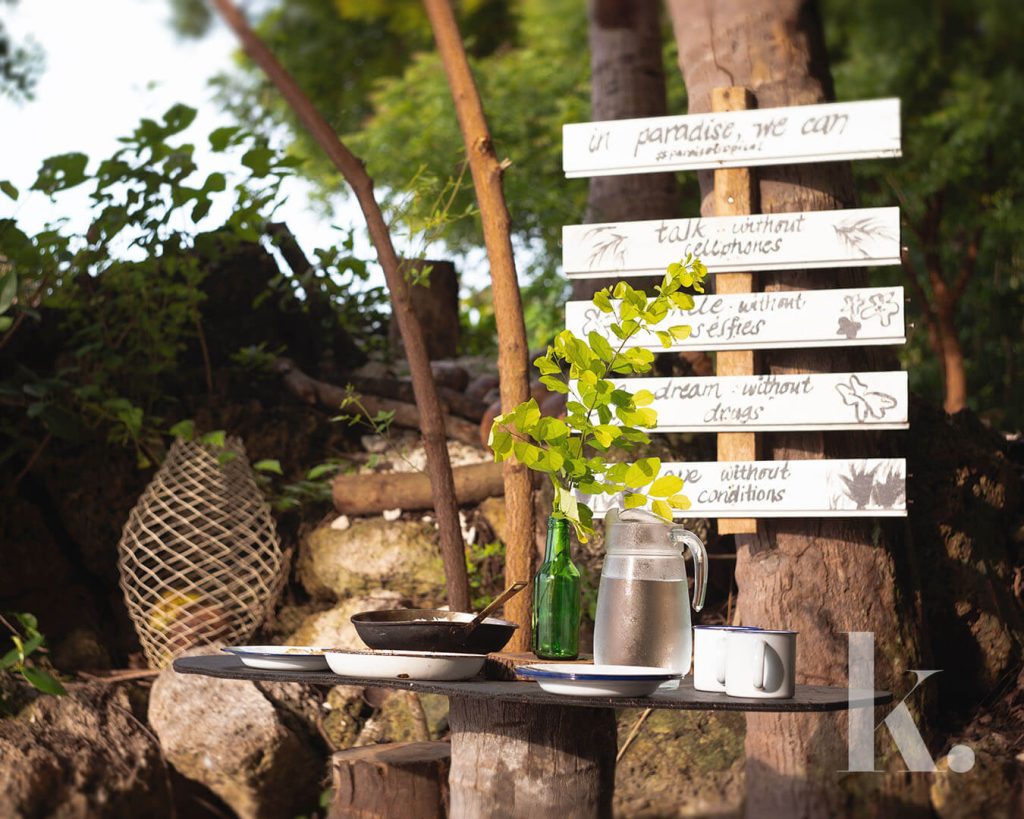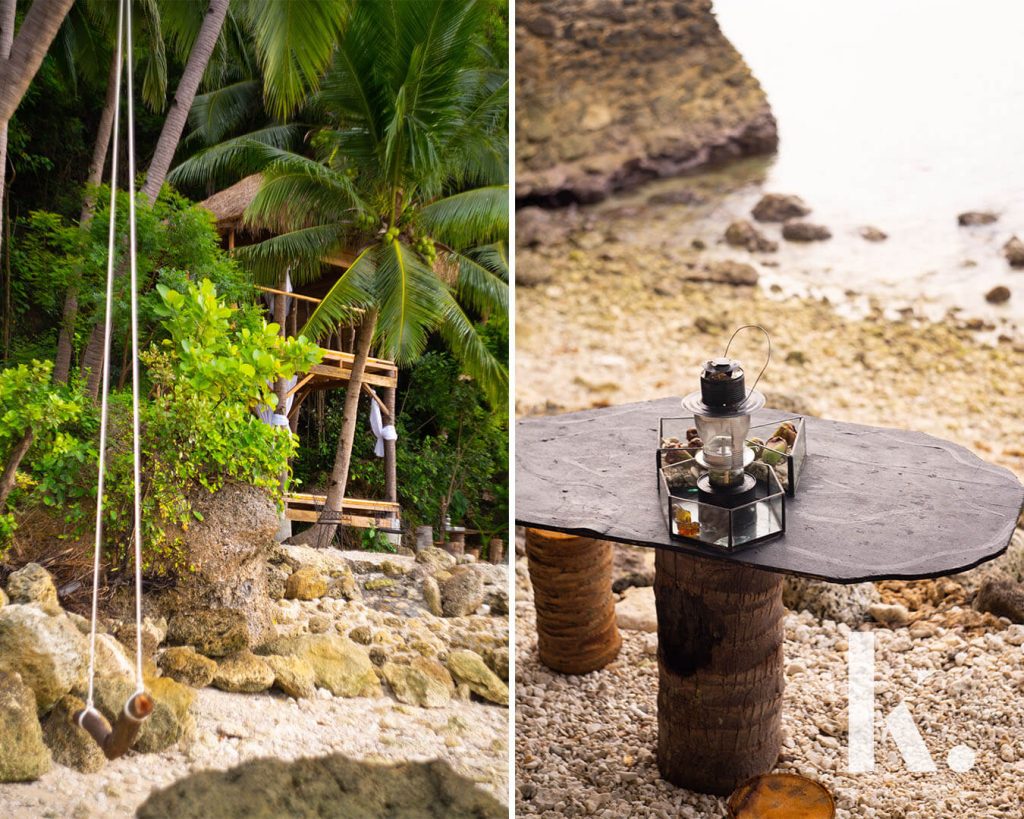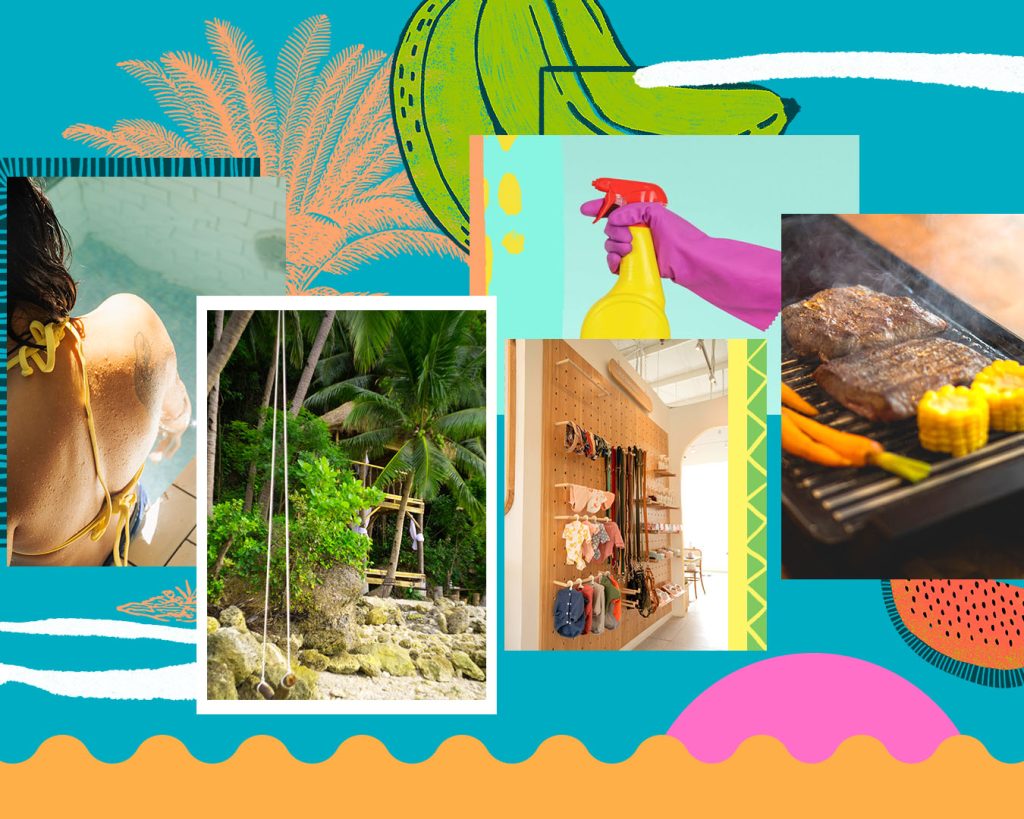About one-third of the drive down to this Oslob resort, Francis Sollano sent me a photo of a nondescript corner of the road, with a large tree and semi-overgrown bushes. “This is the spot,” he said, to which, admittedly, made me laugh. He did say in his Facebook posts that Paraiso Tropicale was a hidden getaway. Considering the way this particular road corner looked like every other bend on the national road, it seems like it’s a getaway hiding in plain sight.
“Paraiso Tropicale is a private cabin, where people would be able to be one with nature and just escape from urban life,” Francis later tells me of his vision for the space. A true quarantine project, Francis had stumbled upon the property on one of his drives down south and promptly took a leap of faith. “I was really looking for property in the south. But I purchased this lot without knowing the topography, or really knowing everything about it.”
At first glance, the lot does present quite a challenge. The property line starts at the road on the cliff, before running down a steep slope to a beach cove. But considering his background in industrial and fashion design, Francis was up for the challenge.

Creating Paradise
An unmarked wooden gate opens up to long flights of stairs, turning on sharp corners through trees. “I love lines and puzzles,” Francis shares. “The stairs, it really had to follow the terrain of the land. We wanted to respect the land. We didn’t want to destroy or move the rocks, or put too much cement.”
The stairs lead to what Francis calls the Black Cabin, the only enclosed space in the area. “The cabin we had lifted, so we wouldn’t destroy the natural boulders that were already in the space,” he shares. The rocks, he continues, were home to three monitor lizards—”the residents of the property,” he laughs.
The cabin is naturally ventilated and features high ceilings and a sleeping loft to maximize air circulation. Francis took a lot of inspiration from his grandmother’s old house to put it all together. You can see this from the position of the windows to let hot air out, and the inclusion of the antique sewing machine that had actually belonged to his lola. “It also represents my background in fashion,” he adds.
“I designed the place so that it always gives you the sense of wanting to know what’s more, what else is coming. We created patches of seclusion and privacy. It’s something I wanted, considering our urban life where everyone knows everybody. Your private life is everybody’s business.”
The cabin was inspired by the traditional bahay kubo. However, Francis admits the bathroom was his way of bringing in modern comforts. The rain shower is a refreshing indulgence after a day of swimming. The sink is another notable feature, which was made from a stone they found on the property that resembled a basin.
A few steps down is the open kitchen. This is where Francis and his companions—workers from the nearby town, who help him with construction—prepare meals for the guests. “I really started to enjoy cooking here,” Francis shares, adding that meals with the guests are a communal affair he looks forward to.
A path runs through coconut trees and other foliage and leads to a resting area with lounge chairs looking out to see. Further down is the open cabana, where Francis chooses to sleep on most nights.

In Synergy with Nature
“I designed the place so that it always gives you the sense of wanting to know what’s more, what else is coming,” Francis says. “We created patches of seclusion and privacy. It’s something I wanted, considering our urban life where everyone knows everybody. Your private life is everybody’s business.” I think we all know what he means.
With that in mind, Francis admits he seldom heads to the city; instead, he chooses to flourish in the haven of tranquility that he created.
Created in quite a literal sense, considering Francis took on a hands-on approach to creating Paraiso Tropicale. From coming up with the layout to the actual construction, he worked closely with the team in making sure it all comes together. He wanted to make sure processes were cost-efficient, yes. But mostly, Francis wanted to make sure they created the space in the most sustainable way possible.
“I love waking up in the morning in the cabana because you would see the golden sunrise. It reminds me that we are always given chances. We have to look for the highest version of ourselves. We can only do that if we find hope every day.”
“For a lot of us, when we think of development, it’s always concrete,” Francis shares. However, this was not a direction he wanted to take Paraiso Tropicale in, considering his background of co-founding Youth for A Livable Cebu and his avant-garde creations made from trash and scraps.
“Being sustainable and respecting nature is one of our primary tenets in the construction of this area,” Francis continues. “Our idea here is that we must not be able to cut a single tree, and I’m very proud of that. Not a single healthy adult tree was cut in the development of this area.”
Even when they did have to cut down diseased coconut trees, he chose to repurpose the trunks for creating the open-air cabana. “We wanted to work with what was available, and what was natural in the landscape of the area,” he continues.
Francis also hopes to convert the property to 100% solar power. “Some of our lights here are already solar-powered. However, the rest are still on the grid.” He does add that though they do have electric lights, they minimize their use at night. “We utilize the least light possible because there’s a hive of fireflies on the property.” Firefly watching is one of the activities they hope to highlight in the future.

A Natural Paradise, by Design
It’s incredible to consider the amount of work that Francis and his companions have put into the space, especially when you consider that it’s the first time he’s worked on a property. Fortunately, his background in industrial design really helped him in the process.
“As an industrial designer, most of the products we do are on a small scale. When we do property design, there are a lot of considerations, mostly on the smart utilization of the space. There’s also the business side—how can we be able to maximize profits while keeping the design intact? It is quite different in the sense of scale and budget,” Francis says. “However, what is very much common is the intention of the design.”
The intention is evident throughout Paraiso Tropicale, where each detail comes with a story and meaning. Francis carefully considered every aspect of the property, making sure that guests are comfortable while still leaving as small an ecological footprint as possible.
Of course, Francis has a lot more plans for the property. “This is the first phase,” he says of all their efforts. “For phase two, we want to make treehouses. We have a huge acacia on the property, so we wanted to install a treehouse there. We also wanted to have cocoon treehouses on the coconut trees.” He laughs when I ask when he plans to start. “Probably in the next two to five years. Hello, investors!”
For now, Francis is content with the laidback quiet life he’s built for himself on this quiet Oslob resort. “I love waking up in the morning in the cabana because you would see the golden sunrise. It reminds me that we are always given chances,” he shares. “We have to look for the highest version of ourselves. We can only do that if we find hope every day.” That definitely sounds like a great reason to head down to Oslob and visit Paraiso Tropicale—who’s with us?
You can book a stay at Paraiso Tropicale through Facebook.



